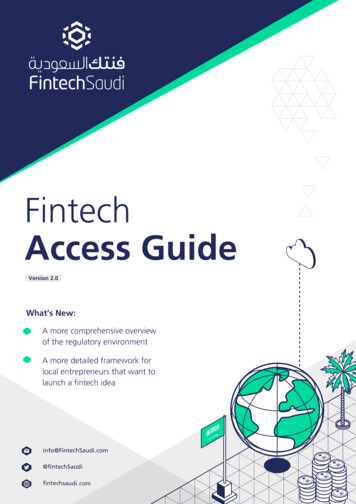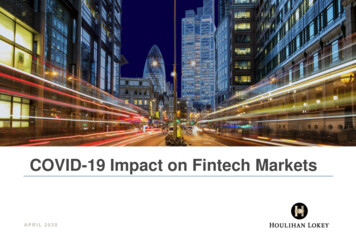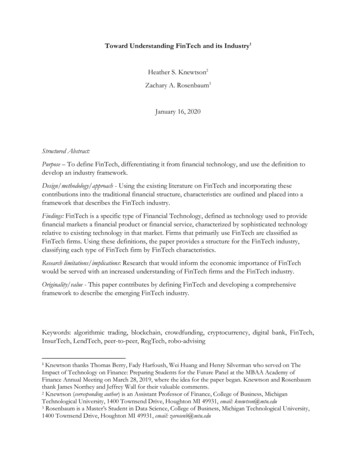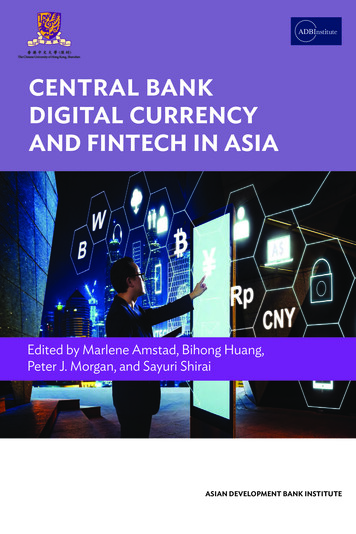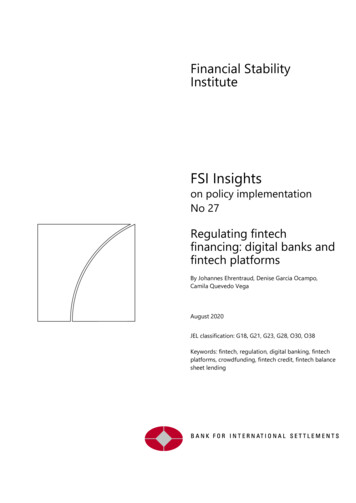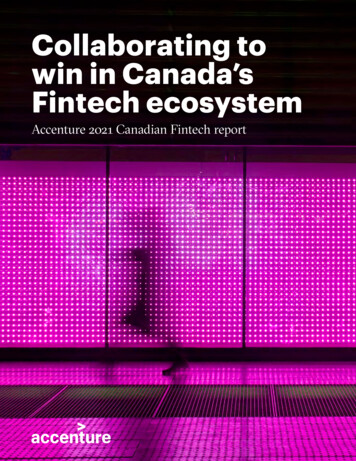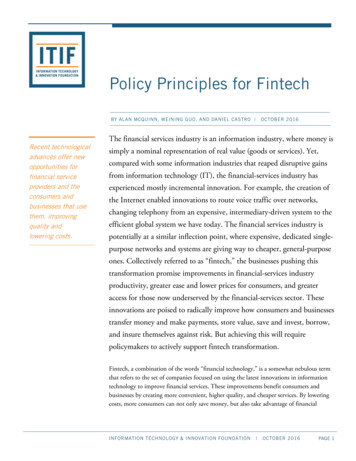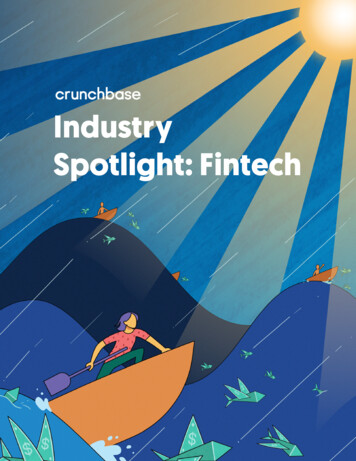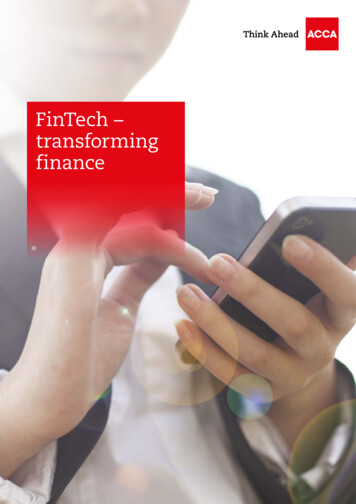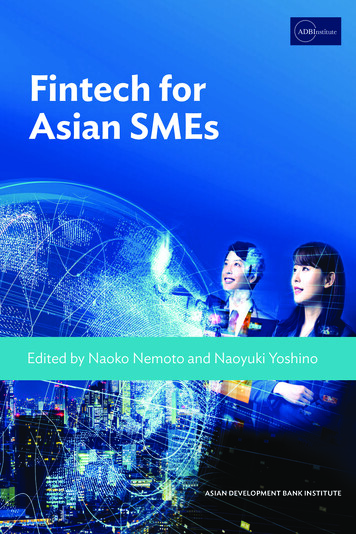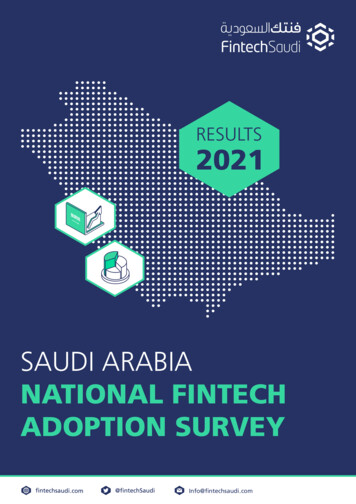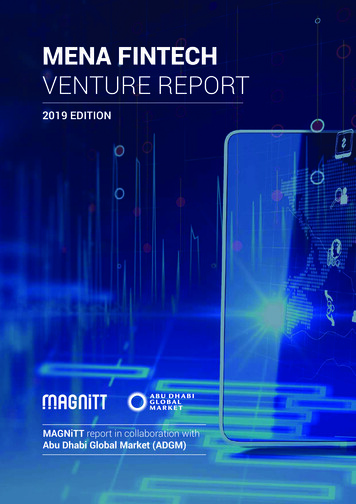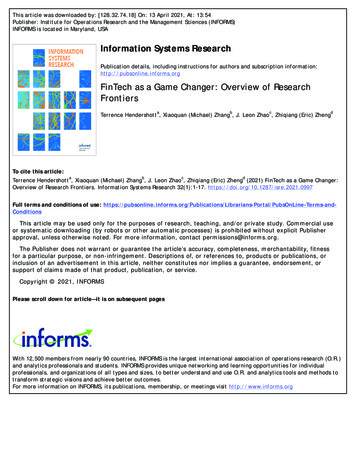
Transcription
This article was downloaded by: [128.32.74.18] On: 13 April 2021, At: 13:54Publisher: Institute for Operations Research and the Management Sciences (INFORMS)INFORMS is located in Maryland, USAInformation Systems ResearchPublication details, including instructions for authors and subscription information:http://pubsonline.informs.orgFinTech as a Game Changer: Overview of ResearchFrontiersabcdTerrence Hendershott , Xiaoquan (Michael) Zhang , J. Leon Zhao , Zhiqiang (Eric) ZhengTo cite this article:abcdTerrence Hendershott , Xiaoquan (Michael) Zhang , J. Leon Zhao , Zhiqiang (Eric) Zheng (2021) FinTech as a Game Changer:Overview of Research Frontiers. Information Systems Research 32(1):1-17. https://doi.org/10.1287/isre.2021.0997Full terms and conditions of use: ians-Portal/PubsOnLine-Terms-andConditionsThis article may be used only for the purposes of research, teaching, and/or private study. Commercial useor systematic downloading (by robots or other automatic processes) is prohibited without explicit Publisherapproval, unless otherwise noted. For more information, contact permissions@informs.org.The Publisher does not warrant or guarantee the article’s accuracy, completeness, merchantability, fitnessfor a particular purpose, or non-infringement. Descriptions of, or references to, products or publications, orinclusion of an advertisement in this article, neither constitutes nor implies a guarantee, endorsement, orsupport of claims made of that product, publication, or service.Copyright 2021, INFORMSPlease scroll down for article—it is on subsequent pagesWith 12,500 members from nearly 90 countries, INFORMS is the largest international association of operations research (O.R.)and analytics professionals and students. INFORMS provides unique networking and learning opportunities for individualprofessionals, and organizations of all types and sizes, to better understand and use O.R. and analytics tools and methods totransform strategic visions and achieve better outcomes.For more information on INFORMS, its publications, membership, or meetings visit http://www.informs.org
INFORMATION SYSTEMS RESEARCHVol. 32, No. 1, March 2021, pp. 1–17ISSN 1047-7047 (print), ISSN 1526-5536 FinTech as a Game Changer: Overview of Research FrontiersTerrence Hendershott,a Xiaoquan (Michael) Zhang,b J. Leon Zhao,c Zhiqiang (Eric) ZhengdaHass School of Business, University of California, Berkeley, Berkeley, California 94720; b Department of Decision Sciences and ManagerialEconomics, CUHK Business School, Chinese University of Hong Kong, Hong Kong, 88888; c School of Management and Economics, ChineseUniversity of Hong Kong, Shenzhen 518172, China; d Department of Information Systems, Jindal School of Management, University of Texasat Dallas, Dallas, Texas 75080Contact: 03-2270-7800 (TH); -2331 (X(M)Z); 624-0254 (JLZ);https://orcid.org/0000-0001-8483-8713 (Z(E)Z)ericz@utdallas.edu,Received: February 8, 2021Accepted: February 8, : 2021 INFORMSAbstract. Technologies have spawned finance innovations since the early days of com-puter applications in businesses, most recently reaching the stage of disruptive innovations, such as mobile payments, cryptocurrencies, and digitization of business assets. Thishas led to the emerging field called financial technology or simply FinTech. In this editorialreview, we first provide an overview on relevant technological, pedagogical, and managerial issues pertaining to FinTech teaching and research, with a focus on market trading,artificial intelligence, and blockchain in finance. And then we introduce the articlesappearing in this special section. We hope that our discussions of potential research directions and topics in FinTech will stimulate future research in the fields of informationsystems and finance toward making their unique marks in the FinTech evolution and theassociated business and societal innovations.Keywords: FinTech financial service blockchain AIfinance, open finance, Secured Automated LendingTechnology, digital currency, micropayments, insurance technology (InsurTech), regulation technology,and token economics (Voshmgir 2019) are some ofthe examples.In the meantime, the boundary between a financecompany and a technology company is becomingblurred. Traditional financial institutes are becoming information technology (IT) companies, whereasIT companies are offering financial services. Manyfinancial-service businesses have been transformingthemselves into IT businesses. Lloyd Blankfein, theformer chief executive officer of Goldman Sachs,holds that Goldman Sachs is more of a cutting-edgetechnology firm, rather than a grey-haired investmentbank (Oran 2015). As a matter of fact, among the33,000 employees of Goldman Sachs, more than 9,000were engineers and programmers.1 As Lloyd succinctly put it, “We are a technology firm. We are aplatform.”2 Goldman Sachs is not alone. Barclayscreated a global community for FinTech innovation,including opening an accelerator in New York. Thecompany used machine learning to reduce the number of mundane, repetitive tasks performed by banksto prepare for client meetings. Capital One and Liberty Mutual’s Alexa solution (a voice-activated personal assistant) allows customers to check balances,pay bills, and track spending through these devices.Financial services are likely going to be around andbe needed, but they may not necessarily be offered by1. IntroductionIt is not a stretch to say that financial technologies(FinTech) are transforming every corner of financialservices. The list goes from deposits, loans, credit,fundraising, leasing, wealth management, investment,insurance, risk assessment, compliance, payment, clearing and settlement, securities, and trade finance tofinancial advising, among others. As summarized byTapscott (2020), financial services are fundamentallyabout authenticating identity and value, transferringvalue, storing value, lending value, exchanging value,funding and investing value, managing and insuringvalue, and accounting for value. All these areas haveexperienced FinTech innovation or disruption. Contemporaneous and emerging information technologies, such as artificial intelligence (AI), blockchain,big data analytics, IoT, cryptography, and cloudcomputing, have gradually become an integral andindispensable part of today’s financial services.Finance industry transformations, as a result ofFinTech, are evident. We are seeing many financialbusinesses being digitized and tokenized, information asymmetry being mitigated, middlemen beingeliminated, human beings being replaced by machines,services becoming more intelligent, governance being decentralized, trust becoming coded and protocolized, security being strengthened, and compliancebeing enforced. Along with the creative destructionof FinTech, it has spawned new ways of providing financial services. Robo-advising, neobank, decentralized1
2traditional financial institutions. Bill Gates famouslysaid in 1994, “Banking is necessary, banks are not.” ITfirms are encroaching into this area. Google, Apple,Facebook, Amazon, and Microsoft, collectively knownas GAFAM, are already active investors in the paymentsindustry; they’re quickly penetrating into the corebusinesses of legacy financial service providers.3 Thistrend is best summarized by Alibaba’s Chairman,Jack Ma, “If banks don’t change, we will changethem.” In 2019, Apple debuted its credit card; in 2020Google launched consumer bank accounts; Facebookis consolidating its payment product under FacebookPay. Facebook is also introducing a potentially gamechanging digital currency, Libra.4 This list is muchlonger. Uber is issuing Uber Money housed in one’sdigital wallet. Amazon has already been in the business of lending for years, setting up student loans.Amazon’s foray into small business lending aligns itmore closely with traditional financial institutions.Since 2011, it has been leveraging the data generatedby small businesses that use Amazon Marketplace,which helped Amazon to identify loan candidates foramounts ranging from 1,000 to 75,000. Amazonreported that it has issued over 1 billion in loans to20,000 small businesses.5 Based on its superb dataanalytics capability, Amazon Web Services is able toprovide services to dozens of finance companies,including Aon, Capital One, Carlyle, Nasdaq, PacificLife, and Stripe.The trend of tech giants stepping into the financeservice territory is worldwide. Rakuten, Japan’s largest online retail marketplace, issues credit cards andoffers mortgages and securities services. China’s Alibaba is another big e-commerce company that acts asan asset manager, lender, and payment firm.6 Itsaffiliated Ants Financial, valued at over 200 billion,has become one of the biggest FinTech companies inthe world. Besides its core payment service, Alipay,it has expanded into products, such as wealth management and loans.7 WhatsApp rolled out its payments feature to select users across India, providing astrong boost to India’s digital payments ecosystem.Brazil’s Banco Bradesco Facebook app allows customers to conduct day-to-day banking from Facebook, using the social network’s customer data analytics to target users. Singapore and Hong Kong arealso in the process of introducing new digital banklicenses to make it easier for tech businesses to offerfinancial services. Likewise, in Europe, technologyenabled banks from Monzo to N26 have emerged,targeting the wallets of younger, tech-savvy consumers.FinTech has been evolving since the early days ofATMs in the 1970s. To understand the business valueof technology to finance, one needs to trace thejourney of financial innovation from the early days ofHendershott et al.: FinTech as a Game ChangerInformation Systems Research, 2021, vol. 32, no. 1, pp. 1–17, 2021 INFORMSFinTech to its present frontiers, such as the fusion ofAI and blockchain with finance. Taking financialcirculation as an example, financial technology hasgone through three stages of development.1. As an early financial technology, the traditionalATM machine realized the automation of cashierwork and improved the operational efficiency ofbanks. However, ATMs have not changed the basicbusiness model of the bank. This stage can be regarded as “the stage where financial technology helpstraditional business models,” which we term as the“ tech” era.2. In the mobile internet era, mobile payment technology has created brand-new technology-based financial institutions (such as Alipay, etc.) and new financial business models. This stage is “the stage wherefinancial technology subverts the traditional businessmodel.” We term this era the “tech ” era because thefinancial service is spawned from the new technology.3. Entering the era of digital currency, some fiatcurrencies have begun to undergo digital transformation. At this stage, changes not only occur inbusiness models but even the national governancesystem is undergoing major innovations. This stageis “the stage where financial technology promotesmajor and potentially game-changing business ecosystems.” We term this era as “tech2,” as the technologyand business ecosystems cohere.It is clear that FinTech not only has changed the waywe do business but also the way we live our dailylives. Given its growing importance, this editorialreview aims to provide a deeper anatomy on FinTechwith research directions. As FinTech itself has becomea huge area, we do not want this editorial review to beall-encompassing. Rather we first zoom in on one ofthe most prevalent applications of FinTech on financial market trading as an illustration of FinTechapplication and then proceed to elaborate the role oftwo of the most important technologies in FinTech, AIand blockchain. We lastly discuss how FinTech education can be improved and provide a brief introduction to the papers included in this special section.2. Application: Technology in FinancialMarket TradingOne area where the technology impact in finance ismost evident is the transformation of securities trading and other financial instruments. Before the substantial automation of the past few decades, tradingwas conducted by humans on physical trading floors.Human clerks in back offices ensured proper processing of transactions. Over time, both the back officeand the actual trading process have been transformedby automation.
Hendershott et al.: FinTech as a Game ChangerInformation Systems Research, 2021, vol. 32, no. 1, pp. 1–17, 2021 INFORMSMany financial markets have moved beyond humanintermediation in floor trading or on the telephone,replacing human intermediaries with electronic limitorder books and other automated trading systems.8In response to the automation of the exchanges, investors and traders developed trading algorithms.Many of these algorithms were designed to replicatethe behavior of humans involved in the tradingprocess, such as agency floor brokers or proprietarymarket makers. Over the past decade or two, thesetrading algorithms have improved, computing technologies have advanced, and buy and sell orders arearriving and matching faster than ever before.A form of algorithmic traders referred to as highfrequency traders (HFTs) exemplifies the innovatingrole of FinTech in trading. The SEC (2010) describedHFTs as “professional traders acting in a proprietarycapacity that engage in strategies that generate a largenumber of trades on a daily basis.” HFTs are oftencharacterized by their use of (1) high-speed and sophisticated computer programs; (2) colocation services and individual data feeds to minimize networkand other types of latencies; (3) very short time framesfor establishing and liquidating positions; (4) thesubmission of numerous orders that are cancelledshortly after submission; and (5) ending the tradingday in as close to a flat position as possible. Thesecharacteristics are used for both arbitrage and marketmaking and are only made possible with new technologies. A central question is whether HFTs improvethe functioning of financial markets in terms of informational efficiency and liquidity.Significant theoretical and empirical literature hasfocused on HFTs’ role in the incorporation of information into price, often called price discovery (seeBrogaard et al. 2014, 2019). If HFTs’ investment intechnologies and algorithms is primarily to react topublic information faster than other traders, thenHFTs can increase information asymmetry.9 This canincrease adverse selection and reduce liquidity because HFTs “pick off” other investors’ “stale orders.”For example, when the S&P 500 futures increase inprice on the Chicago Mercantile Exchange, HFTs raceto buy stocks in New York. Slow investors who cannotcancel their orders fast enough will sell stocks to HFTsunwillingly before prices rise. Anticipating this possibility, slower investors (or even other HFTs) willdemand greater compensation for providing liquidity in terms of a wider bid-ask spread (Budish et al.2015, Shkilko and Sokolov 2020).10 The simple ETFfutures arbitrage illustrates potential tensions between statistical arbitrage and market making. However, it is important to note that the distinction betweenarbitrage and market making is often simpler to see in3theoretical models than in practice. Market makerstrying to avoid being picked off by arbitrageurs canbecome arbitrageurs themselves if other liquidity providers are slower.Although HFTs have grown as a percentage ofvolume, liquidity has improved (see Jones 2013 andMenkveld 2016). Transaction costs for small investors, as measured by bid-ask spread, have declined.Transaction costs for large institutional investors, asmeasured by implementation shortfall, have alsodeclined substantially. Algorithmic trading is generally thought to have been responsible for this liquidity improvement (Hendershott et al. 2011). However, it can be challenging to separate the causaleffects of increases in agency algorithmic tradingfrom the increases in HFTs.Menkveld (2013) examines the entry of a single HFTmarket maker into the trading of Dutch stocks in July2007 and finds a decline in bid-ask spreads and adverse selection. Brogaard et al. (2017) use an instrumental variables approach exploiting differences inthe 2008 short-sale ban’s cross-sectional impact onHFTs and non-HFTs to find that some HFTs’ activitiesare harmful to liquidity during the extremely volatileshort-sale ban period. One way HFTs could harminstitutional investors is by “front-running” nonHFTs’ orders by detecting large non-HFT orders thatare split over time (van Kervel and Menkveld 2019,Korajczyk and Murphy 2020, Yang and Zhu 2020).Beyond the impact of HFTs on average market liquidity, HFTs’ impact during volatile market conditions has been an important area of study (Kirilenkoet al. 2017, Bogousslavsky et al. 2020).HFTs raise important concerns for financial marketdesign. Concerns about the possible deleterious effectsof HFTs have led to many proposals to curb HFTs’actions. Some of the most prominent are (1) transaction taxes, (2) frequent batch auctions, and (3) speedbumps. Colliard and Hoffmann (2017) find that theFrench transaction tax lowers trading volume andreduces liquidity. Budish et al. (2015) and Baldauf andMollner (2020) theoretically study how frequent batchauctions and speed bumps can improve liquidity byreducing adverse selection. Aoyagi (2020) shows howspeed bumps can actually worsen adverse selection byincreasing HFTs’ investment in speed.Future research opportunities on HFTs and technologies in financial markets include (1) the studyof regulatory interventions designed to impact HFTs;(2) the analysis of HFTs’ behavior across markets andsecurities; (3) the study of HFTs that move beyond thestock market; (4) the examination of market data’simpact on HFTs and other investors; (5) analyzing theimpact of HFTs on different types of investors, for example,
4retail versus institutions and passive versus active; (6) theimpact of high-quality investor tools and low-cost tradingby brokerage firms; and (7) better understanding of theimpact of agency algorithms.3. Technology: Blockchain as a NewFrontier of FinTechBlockchain technology is considered to be one of themost disruptive technological innovations since theinvention of the internet (Zhao et al. 2016). The essence of blockchain is a consensus system involvingmultiple parties and a strong security mechanismunder an open architecture (Cai 2018). It relies oningenious distributed algorithms of cryptography andmathematics and uses network computing to enableparticipants to reach consensus on the internet wheretrust cannot be easily established.In recent years, blockchain has become a newsubject of widespread studies in both financial industries and academia (Lacity et al. 2019) on suchtopics as cross-border payments, cryptocurrencies(Ilk et al. 2021), supply chain finance, insurance(Gomber et al. 2018, Goldstein et al. 2019), and newfinancial organizations and processes (Biais et al.2019). In this section, we drill down the technicalnature of blockchain and its implications for financialbusinesses (Chiu and Koeppl 2019).Blockchain is, from the data management perspective, an innovative data structure that includestwo basic features, blocking and chaining. Blocking isthe process that collects data records within a certaintime, such as 10 minutes in the case of Bitcoin (a publicchain). Chaining is a process that hashes the block togenerate a unique identification number for a givenblock. This block ID or hash value will in turn beincluded in the next block, thus creating a chain ofblocks. As a basic tool of modern cryptography, ahash function (or, simply, hash) is a mathematicalalgorithm that maps data of arbitrary size to a bitarray of a fixed size (the hash value). The ideal hash isdeterministic, meaning that the same message alwaysresults in the same hash, and unique, that is, it is (closeto) impossible to find two different messages with thesame hash value.The much-talked-about immutability feature of blockchain as an innovative data structure stems from thesetwo basic properties of hash, being deterministic andunique. The data structure resulting from blockingand chaining enables several new properties of datamanagement that are very different from the relational data structure that are broadly in use in business. In a relational database, removing or modifyingone record will not affect the basic database operation.As such, it is not possible for relational databases to betamperproof, even though one may rely on the systemHendershott et al.: FinTech as a Game ChangerInformation Systems Research, 2021, vol. 32, no. 1, pp. 1–17, 2021 INFORMSlog to track unauthorized operations, which could becompromised. In contrast, blockchain is tamperproofbecause any slight modification to the existing recordsin a blockchain will render the blockchain uselessbecause of the built-in tamperproof features. Of course,blockchain does allow correction of data entry errorsby adding new records, just as in typical bookkeeping operations.3.1. Trends of Blockchain Applications in FinanceAs is well known, finance is the earliest field ofblockchain practice. The original Bitcoin white paperby Nakamoto (2008) advocates a peer-to-peer payment system that prevents double spending. Thetimeliness and immutability of blockchain are especially meant to help resolve financial credit problems.Not surprisingly, financial institutions are activelyendorsing blockchain for digital currency and assetcustody transactions. Stock trading, financial audit,cross-border finance, electronic bills, clearing, andsupply chain finance are some of the many fields thathave harnessed blockchain to solve the problems ofcomplicated credit verification, high cost, long process,and data transmission errors in financial transactions.So far, many blockchain application projects havebegun to move from proof of concept to production.For example, IBM and Ripple launched cross-borderpayment services based on blockchain technology;Hong Kong Monetary Authority, HSBC, Bank ofChina, Bank of East Asia, and Hang Seng Bank cooperated with Standard Chartered Bank and Deloitteto establish a blockchain trade financing platform inthe Guangdong-Hong Kong-Macao Greater Bay Area;Facebook’s cryptocurrency Libra, tries to establish aborderless currency and the financial infrastructureto serve billions of people.Blockchain technology is still in its early stage.Major risks must be prevented at the technical andapplication levels. This is because of the following:(1) At the technical level, it is still difficult to fulfill thesafety, function, and performance requirements ofsome financial scenarios. (2) At the governance level,relevant arrangements for supervision, standards,and talents need to be further improved. (3) There arestill ambiguities at the business level, and applicationinnovations lack authoritative third-party evaluation.At the same time, digital currency, digital identity,and broader financial security (regulatory) infrastructurewill be the three important hurdles to cross for manyfinancial applications.3.2. Killer Finance Applications of BlockchainSupply chain finance (SCF) has been widely regardedas a killer finance application of blockchain technology. Core companies in SCF, including logistics
Hendershott et al.: FinTech as a Game ChangerInformation Systems Research, 2021, vol. 32, no. 1, pp. 1–17, 2021 INFORMScompanies, warehouses, and banks, act as computingnodes in a blockchain financial platform, maintainingthe stability of the system. Other companies, as usersof the system, only participate in financial services butdo not participate in blockchain computing. The mainfunctions of a blockchain SCF platform include (1) managing customer permissions—review user informationand assess user credit risk, and authorize user operating permissions accordingly; (2) managing digital assets—transfer users’ offline assets, audit, andmanage online assets; and (3) provide users withvarious functions for digital asset transactions.In a typical digital asset issuance process, a userconfirms the physical asset application as a digitalasset and the platform audits the physical asset. Itneeds to be connected to the logistics system (e.g., awarehouse) to verify the information on the digitalnotes (e.g., a warehouse receipt) generated though thelogistics system. Common notes transacted in SCFinclude bill of lading, warehouse receipts, accountsreceivable, accounts payable, and invoices. The digitalasset application process and the generated digital assets are recorded on the blockchain. Through the platform, users can list digital assets for trading and otherusers can purchase digital assets on the platform. Digitalasset transactions (e.g., in the form of factoring andreverse factoring) are automatically executed throughsmart contracts, and transaction information is recordedon the blockchain (Cong and He 2019). Enterpriseproduction capacity can also be converted into digitalassets and presold on the platform. Companies canalso issue digital assets for financing through theplatform’s smart contract template and redeem theassets within the agreed period.In the SCF operation, blockchain and smart contracts can be regarded as credible workflows— thisrequires the application of data verification technology to ensure data reliability. Its authenticity verification technology may include physical tracking toensure the accuracy of digital assets. Of course, blockchain anticounterfeiting is not a panacea; relevant lawsand regulations are still needed to reduce crimes, such asselling the same thing more than once. SCF withblockchain technology (Du et al. 2020) has given riseto blockchain platforms such as those being marketedby IBM, Tencent, and Ant Financial.Blockchain can also be used to solve the pain pointsof business links in payment and settlement, such asinterbank joint loan business. The PeerSafe Corporation uses blockchain to build a trustworthy interagency fund reconciliation platform. Smart contractsare used to realize quasi-real-time reconciliation processing, which greatly saves reconciliation time andimproves reconciliation efficiency. The reconciliationplatform is the most common middle and back officebusiness between financial institutions and customers5and is a critical link in fund payment and settlement.Under the traditional reconciliation mode, the twoinvolving institutions generate business records byasynchronous processing, compare them on a case-bycase basis, and deal with the differences in accordancewith the previously agreed upon processing method.Generally, it takes T 3 days (e.g., SWIFT) to completethe reconciliation on day T, which is deficient intimeliness and risk prone. In contrast, blockchainreconciliation helps achieve (1) quasi-real-time reconciliation, which improves processing efficiency;(2) reduced error rate; and (3) ensured data security.There is no doubt that blockchain has promotedthe rapid development of fiat digital currency. Atpresent, the People’s Bank of China is vigorouslyexploring RMB digital currency and electronic payment (DCEP). There are five main reasons: (1) substitute banknotes to further reduce currency issuanceand circulation costs; (2) promote inclusive financeand improve payment diversity and convenience;(3) facilitate internationalization of RMB; (4) respondto the upcoming challenge of private digital currency(such as Facebook’s Libra); and (5) enhance the effectiveness of governance and prevent crimes, such asmoney laundering and terrorist financing.Under the current financial system, issuing fiatdigital currency needs to consider several issues.(1) Fiat digital currency cannot be directly issued tothe public at present and needs to be indirectly distributed with the help of commercial banks, nonbankfinancial institutions, and other financial institutions.(2) Fiat digital currency cannot accrue interest. (3) Whiledeveloping fiat digital currency, cash payments shouldalso be retained for a long time. (4) The implementationof fiat digital currency must be boldly envisaged andcarefully verified. In short, fiat digital currency is asupplement to the existing currency circulation system. In practice, digital currency promotion should begradual to prevent risks, so that it can be integratedwith cash in this process.The large-scale development of blockchain applications requires blockchain platforms to support thevast number of small and medium-sized enterprisesto develop blockchain applications. Under these conditions, the Blockchain-based Service Network (BSN)came into being. It is a public infrastructure networkthat can provide low-cost development, operation andmaintenance, and supervision of alliance chain applications. Using BSN, users can directly build theirown blockchain operating environment and rent sharedresources on demand. BSN is led by the National Information Center and was jointly prepared by ChinaMobile, China UnionPay, and others in 2020. BSN is aglobal infrastructure network based on blockchaintechnology and consensus mechanisms. It is a credible,controllable, and scalable alliance chain for industry,
6enterprise, and government applications. The purposeis to increase the popularity, development, and application of the blockchain technology. Currently, BSNhas established 40 public nodes in China; the newnodes are being expanded to operators in SoutheastAsia and Europe. The successful promotion of BSNwill establish a new type of internet space, which is avalue internet based on blockchain. Its economic andpolitical significance is self-evident.3.3. Blockchain as a Catalyst of SocietalChanges in FinanceAs an emerging technology, the most basic characteristics of the blockchain technology are tamper resistanceand t
FinTech to its present frontiers, such as the fusion of AI and blockchain with finance. Taking financial circulationasanexample,financial technology has gone through three stages of development. 1. As an earlyfinancial technology, the t
